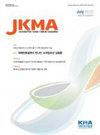Intratympanic injection for treatment of inner ear diseases
IF 0.5
Q3 MEDICINE, GENERAL & INTERNAL
引用次数: 0
Abstract
Background: Intratympanic injection has emerged as a novel approach to bypass the blood-labyrinth barrier and effectively deliver drugs into the inner ear. This technique is used for treatment of various inner ear diseases and overcomes the limitations of systemic drug therapy. In this paper, we provide an overview of the application of intratympanic injection using steroids and gentamicin and highlight the major diseases and summarize the reported efficacy of this approach.Current Concepts: Intratympanic steroid injections have been used for treatment of various inner ear diseases, including sudden sensorineural hearing loss, Ménière disease, and tinnitus. Therapeutic effects of steroids include reducing inflammation, modulating the immune response, improving cochlear blood flow, and maintaining ion homeostasis. Intratympanic gentamicin injections are primarily used to minimize hearing loss and control vertigo symptoms in patients with Ménière disease. Gentamicin selectively injures vestibular hair cells with minimal ototoxicity compared with other aminoglycoside antibiotics.Discussion and Conclusion: Intratympanic injections offer several advantages, including targeted drug delivery, minimal systemic adverse effects, and rapid action. Reportedly, intratympanic steroid injections used as primary or salvage treatment are associated with positive outcomes in patients with sudden sensorineural hearing loss. Ménière disease also shows positive outcomes following intratympanic steroid and gentamicin injections. However, studies have reported conflicting results, and further research is required to standardize dosing and administration protocols. Intratympanic injections are a promising therapeutic option, and ongoing research is essential to optimize their efficacy and safety.鼓室内注射治疗内耳疾病
背景:鼓室内注射已成为一种绕过血液迷宫屏障并有效将药物输送到内耳的新途径。该技术用于治疗各种内耳疾病,克服了全身药物治疗的局限性。本文综述了鼓室内注射类固醇和庆大霉素的应用,重点介绍了主要疾病,并总结了该方法的疗效报道。当前概念:鼓室内类固醇注射已用于治疗各种内耳疾病,包括突发性感音神经性听力损失、msamuni病和耳鸣。类固醇的治疗作用包括减少炎症、调节免疫反应、改善耳蜗血流和维持离子稳态。鼓室内庆大霉素注射主要用于减少msamni病患者的听力损失和控制眩晕症状。与其他氨基糖苷类抗生素相比,庆大霉素选择性损伤前庭毛细胞,耳毒性最小。讨论与结论:鼓室内注射具有靶向给药、全身不良反应最小、作用迅速等优点。据报道,鼓室内类固醇注射作为原发性或补救性治疗与突发性感音神经性听力损失患者的阳性结果相关。在鼓室内注射类固醇和庆大霉素后,msamniires病也显示出积极的结果。然而,研究报告了相互矛盾的结果,需要进一步的研究来规范剂量和给药方案。鼓室内注射是一种很有前途的治疗选择,正在进行的研究对优化其疗效和安全性至关重要。
本文章由计算机程序翻译,如有差异,请以英文原文为准。
求助全文
约1分钟内获得全文
求助全文
来源期刊

Journal of The Korean Medical Association
Medicine-General Medicine
CiteScore
0.50
自引率
0.00%
发文量
84
审稿时长
4-8 weeks
期刊介绍:
The Journal of the Korean Medical Association (JKMA) is the official peer-reviewed, open-access, monthly journal of the Korean Medical Association (KMA). It contains articles in Korean or English. Its abbreviated title is ''J Korean Med Assoc''. The aims of the Journal include contributing to the treatment of and preventing diseases of public health importance and to improvement of health and quality of life through sharing the state-of the-art scientific information on medicine by the members of KMA and other national and international societies.
 求助内容:
求助内容: 应助结果提醒方式:
应助结果提醒方式:


